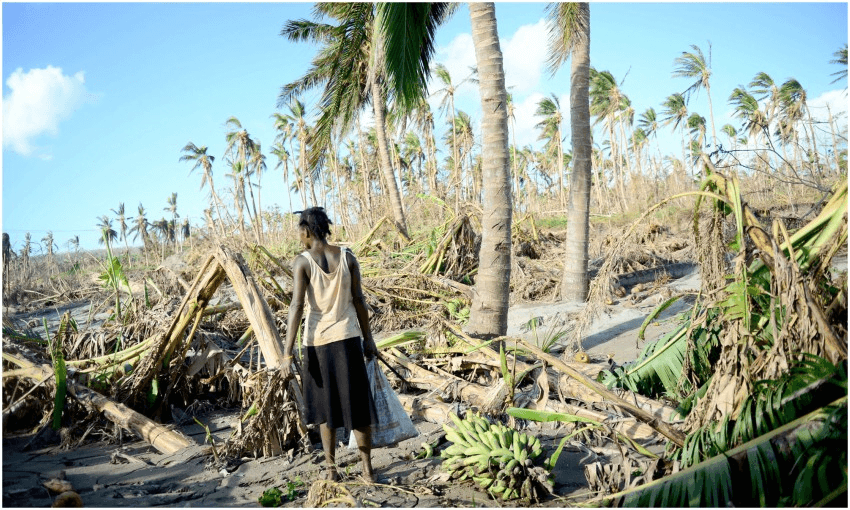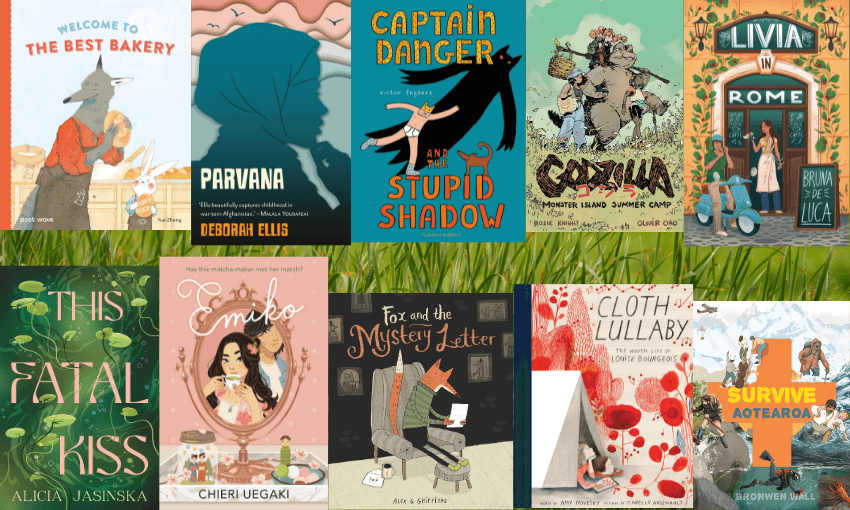Rebecca Tobo Olul-Hossen, a writer from Vanuatu, celebrates a book woven of stories her country has lived through.
This is an edited version of a review that appeared in Vanuatu’s Life & Style Magazine.
Sado, a Bislama word that translates to “shadow” in English, as a noun means reflection, humiliation and dishonor. This is a novel about relationships between families and friends, between and across cultures and communities. It is about how relationships are called into question when something terrible happens. It puts a mark in the sand, telling stories from different points of view about the experience of a disaster and the aftermath of it, a key part of Vanuatu’s history. The novel begins the morning after Tropical Cyclone Pam hit Vanuatu in 2015, as two main characters “wobble out through the sliding door into what Pam has left behind”.
I began reading in early March 2020. The Covid-19 pandemic (the disease itself, as well as the misinformation pandemic) was making its way into the Pacific but was yet far away. The notes I made to myself then were about the multiple parallels between what was going on in the book and what was happening in the rest of the world. Notes about governments scrambling to respond, and the role of international non-governmental organisations and development partners responding to a new type of emergency, coupled with the intense media reports and, to a certain extent, sensationalisation of an issue.
Then wham, as if reading were wishing, and wishes did come true, severe Tropical Cyclone Harold, after Pam the second-most powerful storm to strike Vanuatu, hit on 6 April 2020. Gaining strength to the west, it made landfall as a category five cyclone with sustained winds of over 215 km per hour and gusts of up to 235 km per hour. This caused widespread and severe damage throughout the northern part of Vanuatu. A third of the country – 92,300 people – were affected, of which 24,300 were children.
At that point I felt like my reading Sado may have jinxed the whole thing and invoked this monster. In reality I knew that books were not that powerful (that only happens in R.L. Stein books, one of the many books I scared myself to death with growing up). But they are powerful in other ways. Books allow the capturing of experiences of individuals and communities at a particular point in history.
Then I really had to put the book aside and, like Cathryn, the key protagonist of Sado, (because I did work in one of those agencies described so vividly in the book) begin supporting the response to Tropical Cyclone Harold. There were now just too many parallels between the book and reality – too much for comfort at times.
It’s hard, once you’ve been through an experience, to distance yourself from it and not feel anything. On Pentecost Island, I heard the story of a woman who took shelter in a church building that lost parts of its roof and was completely flooded. “We could see the roof peeling off and the ceiling tearing up like a piece of paper,” she described, almost losing hope. She had three children with her, one a seven-month-old baby.
Her story of moving from corner to corner trying to find a spot where the wind and rain would not reach resonated with my own story the night of Cyclone Pam five years ago. I had a three-year-old and a six-year-old as well as my mother, in her late 50s then, in the house. They were depending on my younger brother and me, a single mother, to keep everyone safe. There was a point at the peak of the cyclone when I thought our house would not make it. And how silly it was that I didn’t even know where the nearest evacuation centre was. But my story was just one of many, as Sado shows.
Sado is one of the first books I have picked up where I could see a bit of myself and others around me, as well as our individual and combined experiences written in print. The book is firmly set in Vanuatu. I could see where I lived and what was familiar to me. I could smell, taste and feel this story as strongly as I did the emotions and thoughts running through my mind the night of cyclone Pam.
Introductions: Cathryn is an NGO worker from New Zealand, who works and lives in Port Vila with her teenage son, Tarn. Cathryn’s Ni-Vanuatu boyfriend, Pedro, is on Pentecost Island when the cyclone hits and they struggle to establish contact with the phone lines down. Faia, a community worker, radio journalist and survivor of domestic violence is a fiery character fighting for women’s voices and spaces.
A loveable character in Sado is Reimon, the house help. Intriguingly Reimon’s soliloquy is partly written in Bislama, Vanuatu’s lingua franca, and partly in English – again, a first that I’ve seen in print. There is a part of the inner monologue that is unwritten, Reimon’s mother tongue, which reflects the intense multilingualism of Vanuatu. It is not uncommon for someone to speak three languages fluently and understand another one or two. There is the mother language that one thinks, dreams and cries in, then processes into spoken language. This makes sense when you think of a country with 120 languages and a population of roughly 280,000 – of course as few as 2,000 people would call a language their mother tongue. Telling stories from different points of view in a national language is powerfully done in this novel.
Syman’s ability to create fierce and believable women characters who are both compassionate and resilient is to be applauded. These women have their own beasts to deal with but place the concerns of the wider community and society at the forefront. The book touches on the taboos and misconceptions of being a woman in Vanuatu, while navigating a context of strong traditional values that is increasingly urbanised and subject to an intermarrying of different cultures – a somewhat difficult fit. She writes about the colourful underbelly of Vanuatu society, one often unavailable to tourists and short-term visitors, but which as a resident and a Ni-Vanuatu you come into contact with constantly, whether you want to or not. Stories of battered women. Stories of incest. Stories of violence towards people who are seen to be slightly different. Stories of the rise and use of social media to condone these attitudes.
A third of the way into the book, a terrible accident occurs. It creeps up on you and throws a lot of things into motion. Emotions run high. The friendship between Cathryn and Faia is tested by fire. There are strange investigations at work; colleagues attempt to provide support, though somewhat awkwardly. The philosophical question of whether two wrongs made a right is brought up, whilst the friction around the place and role of kastom and the western justice systems is clearly in play.
Many things are called into question and brought forward for the reader to consider. The relationships between mothers and sons and between mothers and daughters, as well as between women friends, are a few. The tensions of inter-racial relationships are highlighted. In the periphery is the reality of the power relations between an aid organisation and a community water committee. All of these tensions make great fodder for this amazing, yet familiar story. Sado’s contribution to the literary scene in Vanuatu, through the telling of stories about an experience that unites a nation, cannot be overstated.
Sado, by Mikaela Nyman (Victoria University Press, $30) is available from Unity Books Wellington and Auckland.



